The city of Paphos, which is the center of the eponymous region of the Republic of Cyprus, is located on the south-western side of the island of Cyprus, next to the spurs of the Troodos mountain range. Paphos (Cyprus) is the fourth most populous city in the country, with 80 % of residents speaking Greek as their first language, while the remaining 20% speak Turkish.
The city is divided into Kato Pafos (Lower Pafos) and Pano Pafos (Upper Pafos), which is often called “Ktima”. Ktima is a modern district where city administrative buildings are located. Kato Pafos is a coastal urban area, where most of the attractions, restaurants, and retail outlets are concentrated.
Interesting fact! The city of Paphos (Cyprus) and the city of Aarhus (Denmark) were recognized as European Capitals of Culture in 2017.
The long coastline with a large variety of beaches, an abundance of places to stay, excellent tourist infrastructure and high – quality service-all this has contributed to the fact that the city of Paphos has become the second most popular resort in Cyprus.
Interesting fact! If you believe the myths, Paphos is the birthplace of Aphrodite, the Greek goddess of love and beauty.
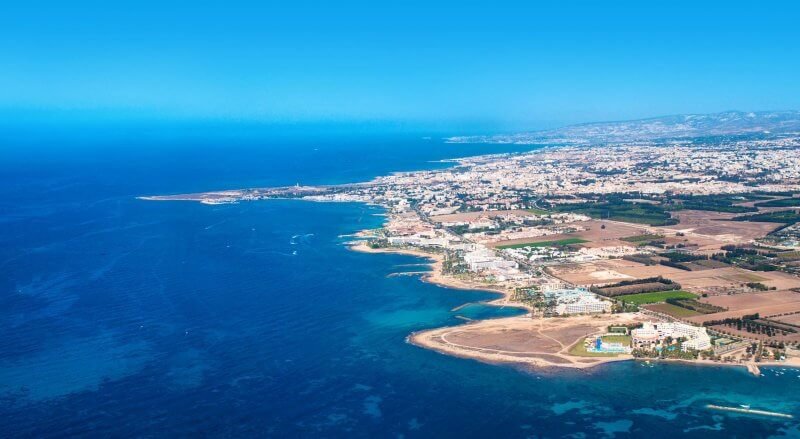
City attractions
This article contains all the most interesting things about the city of Paphos. There is also a lot of practical and useful information for tourists interested in historical sites.
Paphos Waterfront and Port
The embankment is one of the most picturesque places where both tourists and citizens like to relax. The main promenade starts in Kato Pafos, runs along the entire port and stretches to Municipal Baths Beach. This is the busiest part of the boardwalk, where the best bars and restaurants of the city are concentrated.

Then, from the Municipal Baths to Geroskipou, stretches Coastal Broadway. This is the most beautiful part of the city embankment – a narrow well-groomed path, part of which passes under the cliff. Such landscapes encourage leisurely walks, and tourists like to take photos here as a souvenir of Paphos and Cyprus.
Then there is the Geroskipou embankment, surrounded by flowering vegetation. The main part of the Geroskipou boardwalk passes next to hotels, almost directly standing along the coast.
The city’s port is located on the territory of Kato Pafos. In the harbor there are yachts, boats of local fishermen, pleasure catamarans-you can go to the open sea or take a walk along the sea coast.
Paphos Fort
In Kato Pafos, next to the port, there is a medieval Pafos Castle. This building is not only the best attraction of the embankment, but also a business card of the whole city. For all the time of its existence, this structure served as a fortress, prison and even a salt warehouse during the British occupation of Cyprus. And since 1935, the ancient fort has been under the protection of the Cyprus Department of Antiquities.

Now the Paphos Fort is a two-story stone structure with a tower and a nice enclosed courtyard. On the second floor, reached by a wooden staircase, there is an open area-from there you can see the harbor, the Central Embankment and the Mediterranean Sea.
- The fort is located at Kato Paphos Harbour, Coastal Broadwalk, Paphos Cyprus.
- The attraction is open to the public daily at the following times: April 16-September 15-08: 30-19: 30, September 16-April 15-08: 30-17: 00.
- The entrance fee is 2.5€.
Paphos Best 3-Star Hotels with Direct Sandy Beach Access
Kato Pafos Archaeological Park
Kato Pafos Archaeological Park is one of the most interesting archaeological sites in Cyprus, and it was added to the UNESCO List in 1980. The complex combines the ruins of four villas, the castle of Forty Columns, the Odeon and Asclepion, as well as a lighthouse.
Of the rather large Aeon House dating from the fourth century, only 3 central rooms with a unique mosaic floor have been excavated, depicting scenes from the life of the god Aeon. This floor mosaic is a work of ancient Roman art, the only such attraction in Paphos.
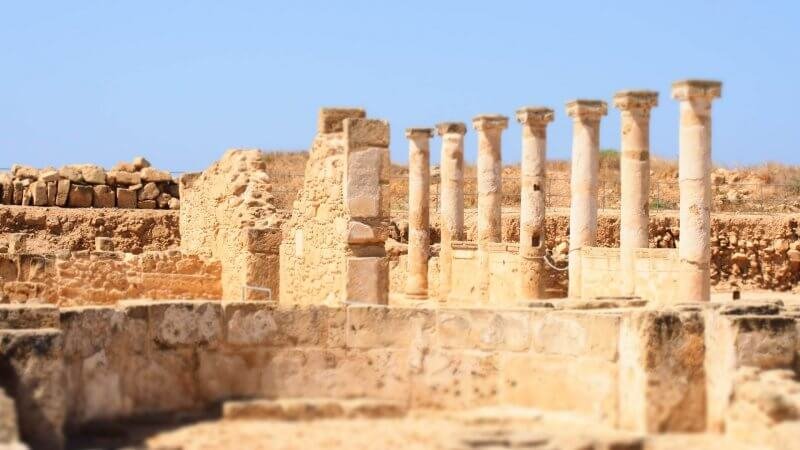
The House of Theseus is the largest building in the complex. Built in the II century, it was used literally until the end of the VII century. So far, only the southern half of the villa has been excavated, where the 36th room deserves the most attention. The luxurious floor mosaic, created in the III-IV centuries, contains scenes depicting Theseus and the Minotaur.
The most inconspicuous of the attractions of the archaeological complex is the House of Orpheus. There are only small fragments of ancient walls.
On the territory of the House of Dionysus there is an inner courtyard (atrium), from which 4 corridors diverge to different rooms. In the rooms you can see a mosaic of the II-III centuries, which depicts the mythological monster Scylla: partly a woman, partly a fish and partly a dog. Of all the mosaics that have been found in Cyprus, this is the oldest. Another 4 unique mosaics contain scenes from the life of the god Dionysus.
The lighthouse is the latest attraction of the complex. Next to the lighthouse is a small observation deck, from which you can admire the Mediterranean Sea, beaches and the surrounding area.

The ancient Roman Odeon Theater, built in the II century, has 12 restored spectator rows. In summer, the Odeon, which can accommodate 1,000 spectators, hosts open-air concerts and performances.
Saranta Kolones, which means “Castle of Forty Columns” – is another object of the park. Although only ruins remain of the castle, it is considered one of the most significant archaeological sites in Cyprus.
Important! The paths are covered with fine gravel, you must take comfortable shoes. The territory is open, in the heat you will need a hat and sunscreen. You also need a supply of drinking water.
- Address of the Archaeological Park: Kato Paphos, Cyprus.
- You can visit the attraction on any day: April 16-September 15-8: 30-19: 30, September 16-April 15-8: 30-17: 00.
- Entrance fee-4,5 €.
Royal tombs
Another attraction of Paphos in Cyprus is the Royal Tombs. Despite the name, the necropolis was not used for kings – it was used to bury high officials, prominent personalities and representatives of the nobility.
The royal tombs occupy a fairly large fenced area with the remains of underground burial chambers carved into the rocks. There are 8 graves located on this territory: they are numbered, each with a sign with information placed next to it.
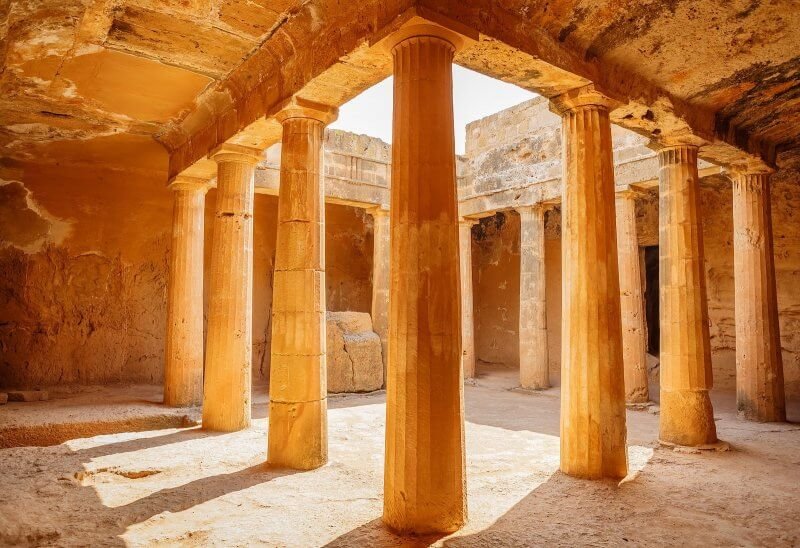
Many tourists who come to Cyprus go to this attraction of Paphos for the sake of beautiful photos.
- The royal tombs are open to the public daily at the following times: from September 16 to April 15-from 8: 30 to 17: 00, from April 16 to September 15 – from 8: 30 to 19: 30.
- The entrance fee is 2.5€.
- Entrance to the territory of the attraction from the street of the same name – Tombs of the Kings Ave.
Agia Kyriaki Church and St. Paul’s Column
What else to see in Paphos is the Church of Agia Kyriaki (aka Panagia Chrysopolitissa). This temple is an active one, and anyone can enter it. Inside, the room looks quite simple and at the same time very solemn.
Excavations are taking place around the church, and since 2013, a circular ramp has been set up specially for tourists, from which you can see the remains of pagan structures: floor mosaics, column bases, arches.

On the north-east side of the church of Agia Kyriaki, there is another attraction that is recognized as one of the most amazing places of worship in Cyprus. This is the column of St. Paul, or rather, only a fragment of it – a white marble pillar about two meters high. According to legend, the Romans tied the Apostle Paul to this pole and beat him with whips because he preached Christianity.
- Address of the attraction: Pafos Afroditis, Paphos, Cyprus.
This is interesting: The scriptures say that the apostles Barnabas, Paul, and Mark visited Paphos in 45 AD, when they made their first mission trip to Cyprus. The Roman governor Sergius Paulus, who listened to Paul and converted to Christianity, was the first of those who “introduced” this religion to Cyprus.
Monastery of St. Neophyte the Recluse
The Monastery of St. Neophytos is a special attraction of Paphos, because many tourists call it the most benevolent monastery in Cyprus. It is located in the village of Tala, approximately 10 km north of Paphos.
In the XII century, the Cypriot hermit Neophytos cut a cave in the rock. Over time, a monastery was created near it, which now houses only a few monks.

The monastery has a museum where you can see many interesting exhibits: a collection of pottery, monks ‘ clothing, religious objects, as well as ancient books, manuscripts and icons.
- Address of the attraction: B7 134, Mesogi, Cyprus.
- There is a bus number 604 from the Karavella station in Pano Pafos to the monastery.
- You can visit the shrine on any day at this time: May-October-9: 00-13: 00 and 14: 00-18: 00, November-April-9: 00-16: 00.
- You can visit the monastery for free, and a ticket to the museum costs€2.5.
Pafos Beach Holiday
Visiting Cyprus for a holiday on the Mediterranean coast is best from mid-April to the end of October, when the weather is most suitable. In addition, at this time, lifeguards are working on the beaches with all the necessary equipment.
All the beaches of Paphos have the necessary infrastructure for a comfortable stay: toilets and showers, changing cabins, sun beds and umbrellas (2.5€ per day). There are beaches with equipped playgrounds for sports and children’s games.

Municipal Baths
This 100-meter-long beach is located in the center of the Kato Pafos coast. There is no sand or pebbles here – the beach area is concreted and has a wide wooden surface running along the shore. There is no good entrance to the water, but there are piers with stairs descending from them.
Vrisudiya V
This is a narrow and short beach, where sand is mixed with pebbles in places. Thanks to the breakwaters installed at the edges of the beach, it has the shape of a semicircular bay. The water in this bay is always calm. The entrance to the water is smooth, the bottom is without stones.
SODAP

SODAP is one of the most popular beaches in Cyprus. It is located next to the Central Boardwalk and has a length of almost 300 meters. The beach is filled with sand, here and there mixed with small and large stones.
The beach is cleaned up daily by municipal employees, but seaweed is still sometimes found.
Pharos
Faros beach is a fairly extensive coastal strip with a length of 400 meters. Among the soft light sand, there are pebbles and large stones. Although the beach is constantly being cleaned up, there are always seaweed on the sand and in the water. The sea floor is inconvenient because of rocks, and to make it easier to enter the sea, a pier with a ladder was equipped on the beach.

Kefalos Beach
The beach next to the Kefalos Hotel is narrow, covered with gray sand and pebbles. Along the coast there is a decking made of planks, next to a green lawn with sun loungers. The bottom is strewn with rocks, and to go into the water was more convenient, built a special pier with a ladder.
The beach is clean, but seaweed is not uncommon here.
Coral Bay
Coral Bay is a separate beach area at the southwestern end of the city, known for its clean sandy beaches, calm sea, lack of algae, and smooth descent into the sea.
Coral Bay includes Laura Beach and Coral Bay Beach-in Paphos, they are recognized as the most comfortable for families with children.
Paphos: 15 Best 4* All-Inclusive Hotels with Private Beaches
Holiday prices
In the Republic of Cyprus, it is the city of Paphos that is the most expensive holiday destination. The resort is aimed at a rich public, and the price level here is quite high: the average cost of tourists during their vacation is 10% higher than in any other city on the island.Habitation

Most of the hotels in Paphos have level 4* and 5*. Since initially this respectable resort was designed for travelers from Western Europe who prefer to relax by the pool to rest on the beach, these hotels are not located near the sea. Prices in such hotels in high season start from€ 100 per night for a double room (breakfast included).
There are also 3* hotels in the resort, where a room for two costs from 50€ per day.
You can also rent a private villa or apartment – this option is great for a family or large company location.
The city of Paphos is famous for its fish taverns-they are very numerous along the coastal zone, and in season they are always filled with visitors. You can eat together in such an institution for an average of 30-40€, for this amount you can order seafood with rice or potatoes, grilled fish, vegetable salad, sauce.
There are luxury restaurants in the city, where dinner with wine will cost at least 110€ per person.
Far from the tourist area, there are many cozy taverns. A three-course set with homemade wine in such an institution will cost 25-35€ per person.
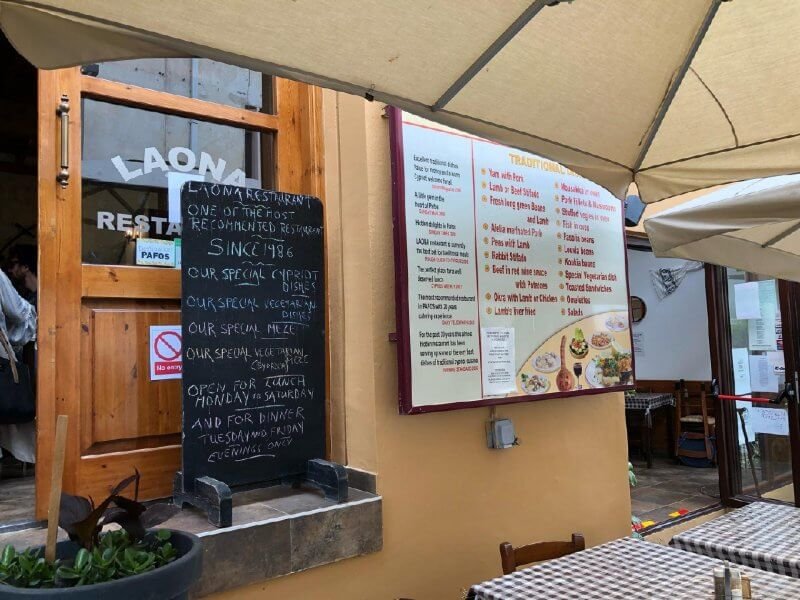
McMeal in McDonalds or similar food in fast food establishments will cost 6-7€.
- Strong coffee can be drunk for 2.5€, cappuccino-for 2.9€, frappe-for 2€.
- Imported beer (0.33 l bottle) costs 3.25€, local beer (0.5 l per bottle) costs 2€.
- The price of a bottle (0.33 l) of regular water is 0.75€, pepsi or Cola (0.33 l) – 1.37€.
How to get to Paphos from Larnaca
There is an international airport in Paphos. That is why, in most cases, travelers prefer to fly to the airport of Larnaca, and from there get to the place of rest by taxi or bus. Since there are no direct flights, you will need to take a bus route with a transfer at one of the following locations:
- Paphos Airport;
- Limassol;
- Larnaca.
So, how to get from Larnaca to Paphos on a case-by-case basis.
Transfer at Paphos Airport
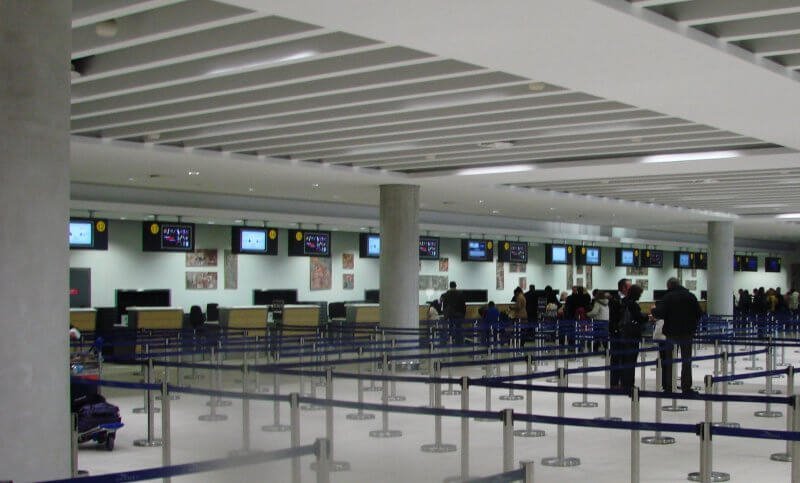
There is a bus service between Larnaca and Paphos airports, there are 2-4 flights a day, but the schedule is constantly changing. All changes are available on the site www.kapnosairportshuttle.com. The ride lasts 90 minutes. The price of an adult ticket is 15€, a child ticket is 5€.
At the airport of Paphos, you will change to the city bus number 612 (http://www.cyprusbybus.com/routedetails.aspx?id=180) or # 613 (http://www.cyprusbybus.com/routedetails.aspx?id=182) – they go to the bus station and Coral Bay beach. There are about 20 flights a day, and the trip lasts 30 minutes. A ticket for an adult costs€ 5 during the day and€ 2.5 at night, while a ticket for children aged 6-12 costs€ 0.75 and€1.25 respectively.
Transfer to Larnaca
From the airport by bus №№ 417, 418, 419, 425, 429 you need to get to the city center at one of the stops: Finikoudes Bus Stop or Old Larnaca Hospital. Travel costs € 1.5 during the day and€ 2.5 at night. Travel time is 30-40 minutes. The schedule is available on the website of Zenon Larnaca Buses: www.zinonasbuses.com.

At the same stop, you need to take the green Intercity Bus that goes to Paphos. Travel time is approximately 2.5 hours. The ticket price for adults is 7€, for children-3,5€. The intercity bus on this route runs only on weekdays. The current schedule can be found on the website: www.intercity-buses.com.
Transfer in Limassol
From Larnaca Airport to Limassol, you can take an express shuttle. The fare is 9€ for adults and 4€ for children 3-12 years old. The transfer time is 50 minutes. There are up to 18 flights per day (from 4: 00 to 1: 00). The exact schedule is available here: http://enlimassolairportexpress.eu/?page_id=8. Get off at the Agios Georgios Havouzas Church stop.
You also need to take the Limassol – Paphos bus there. The transfer takes about 2 hours. Adults need to pay 4€, for children from 6 years old-2€. The bus schedule for this route is available on the website www.intercity-buses.com.
From Larnaca Airport by taxi

Taxi drivers always stand at the exit of the Larnaca airport building. But still, it is better to order a taxi before departure on vacation, then on arrival the taxi driver will meet his passengers with a nameplate. The Kiwi taxi service is perfect for this purpose.
Taxi prices in Cyprus are fixed by law, travel from Larnaca Airport to Paphos costs€ 100.51 during the day and€ 117.41 at night.
Drive from Larnaca to Paphos (Cyprus) about 1.5 hours.


